Building Bridges, Not Walls: 5 Effective Ways for Transforming School Culture with Restorative Practices
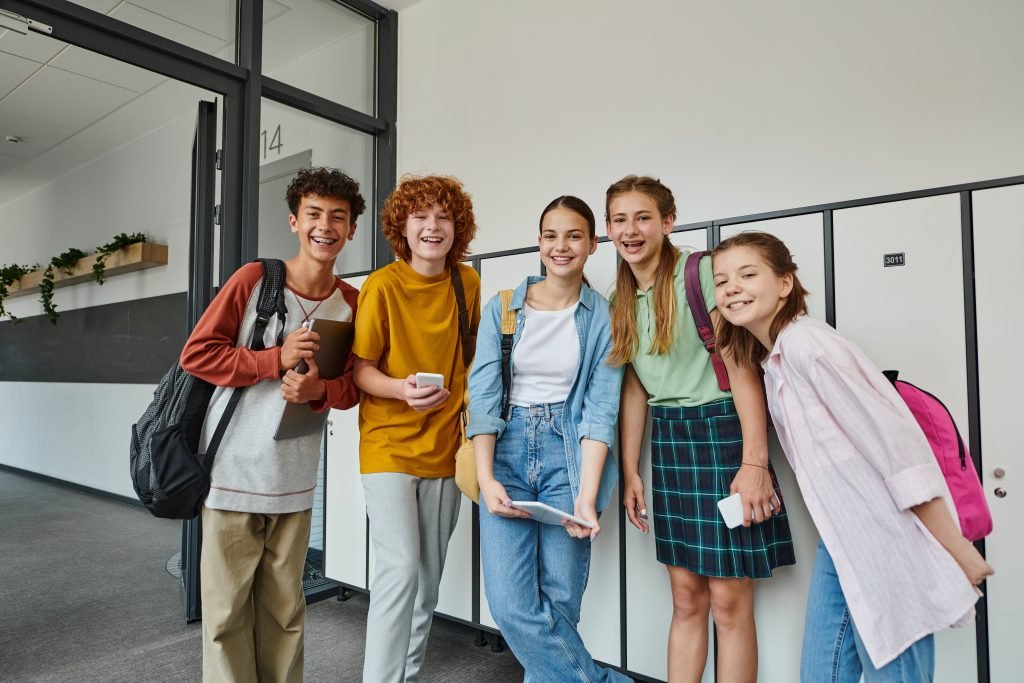
Imagine walking into a school where, instead of heading straight to detention for a slip-up, students sit in a circle, talk it out, and really dive into the why’s and how’s of the situation. That’s the heart and soul of restorative practices in schools.
We’re talking a full-on shift from the “you’re in trouble” vibe to a more “let’s understand and grow together” atmosphere. It’s all about flipping the script on how we handle mistakes and conflicts, making the school a place where every voice matters.
What’s the Big Deal About Restorative Practices?
At its core, restorative practices are like the cool, understanding teacher everyone loves—focused on healing and strengthening relationships rather than just punishing. It’s about asking, “How can we fix this together?” rather than “Who’s to blame?” This approach helps students, teachers, and even parents come together to solve problems, understand each other better, and build a community that’s based on respect and empathy.
To get started on this journey, the Restorative Practices Workbook offers a solid foundation. It’s a comprehensive guide that educators can use to understand and implement community circles effectively.
Kickstarting the Restorative Revolution in Schools
Ready to shake things up in a big way at school? We’re talking about kickstarting a real revolution, but not the kind with flags and protests. This one’s all about swapping out the old “time-out” and detention playbook for something way cooler and way more effective.
It’s about bringing restorative practices into our schools, where talking things out, understanding each other, and fixing things together is the new norm.
Think of it as the difference between just saying “sorry” because you have to and actually working to make things right because you want to.
So, as we dive into this journey together, remember: it’s not just about ditching the detention slips; it’s about building a school vibe where everyone feels like they belong, they’re heard, and they matter.
Let’s get this restorative party started!
Getting the Basics Down
It all starts with understanding what restorative practices are all about. This means creating safe spaces where students feel comfortable sharing their feelings and experiences. They’ll be heard and not judged. Educators lead the charge, learning the best ways to facilitate these open conversations and set the tone for genuine dialogue.
This includes learning the 6 Steps for facilitating a restorative circle – preparing a circle, establishing a safe and respectful environment, opening, facilitating, closing and then follow up/reflection. Through the Restorative Justice Portfolio it explores each of these 6 steps into detail.
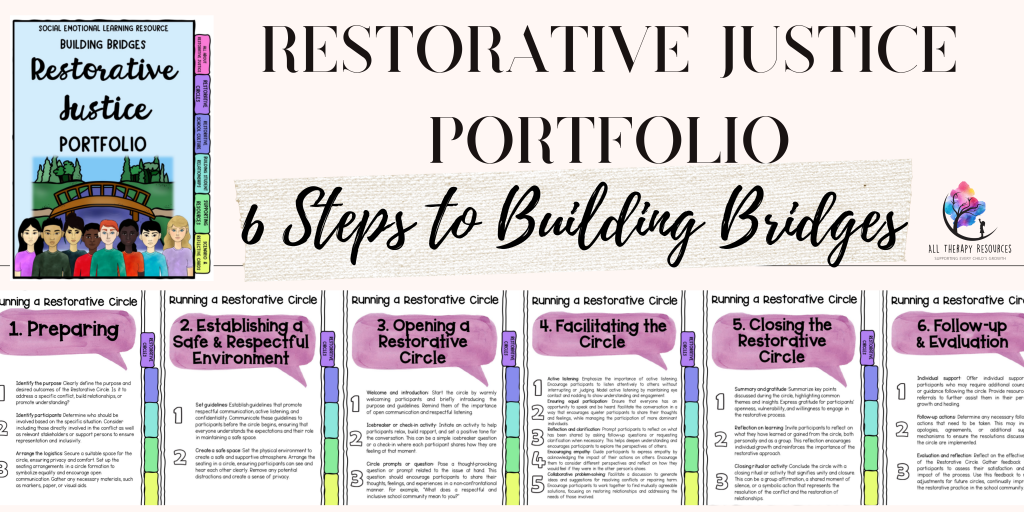
Early Lessons in Empathy
For the younger crowd, integrating empathy and understanding into their daily learning is key. Through activities and guided discussions, kids learn how to express themselves, listen to others, and collaborate to solve problems. It’s all about laying a solid foundation that will serve them well beyond the school walls.
For educators looking to foster empathy and understanding among younger students, RESTORATIVE CONVERSATIONS for Kids provides a suite of activities designed to engage kids in meaningful dialogue
Navigating the Teenage Terrain
Teens are dealing with a lot, from personal growth to social pressures. Restorative practices offer them a space to voice their concerns and challenges in a meaningful way. It’s about equipping them with the skills to handle conflicts, forge stronger relationships, and see the ripple effect of their actions on the community.
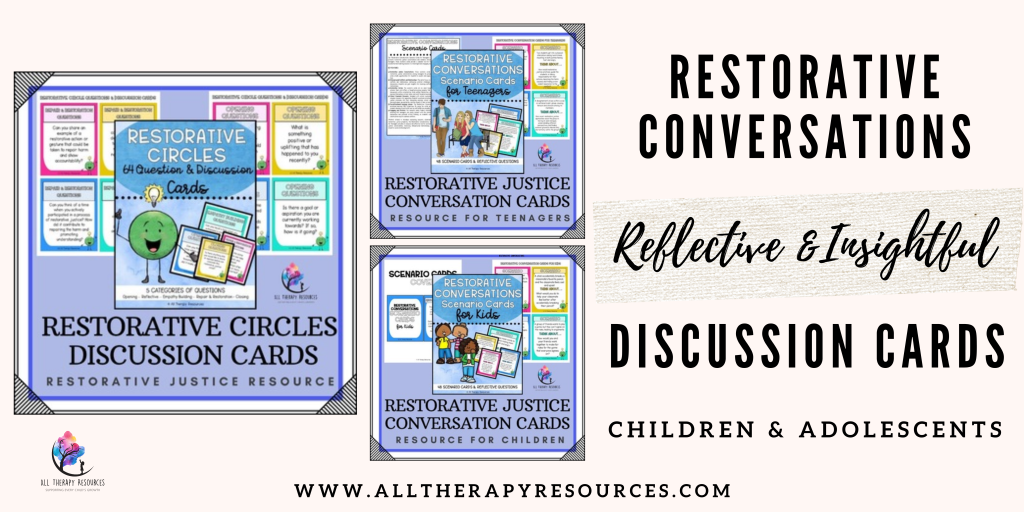
Creating a Culture Shift
Beyond individual and group sessions, transforming the overall school culture is crucial. This means regular community circles that involve everyone—students, staff, and sometimes parents—to discuss broader issues, celebrate successes, and address challenges. It’s about making restorative practices a part of the school’s DNA, where everyone is committed to maintaining an environment of mutual respect and continuous improvement.
To cultivate a restorative culture throughout your school, RESTORATIVE COMMUNITY CIRCLES Questions & Discussion Cards provide versatile discussion prompts that can be used in various settings, helping maintain an atmosphere of respect and open communication.
- Empowering Student Leaders
An often overlooked aspect is empowering students to take the lead in restorative efforts. By training student mediators or ambassadors, schools can create a peer-led support system. These student leaders can facilitate discussions, mentor their peers, and help maintain a restorative culture. It’s a powerful way to foster leadership skills and ensure sustainability of the restorative practices.
The Impact of Restorative Practices In School
Schools that have embraced restorative practices report some pretty amazing changes. We’re talking fewer fights, less bullying, and a whole lot less of the usual drama. But it’s not just about reducing the negatives; it’s also about boosting the positives—like stronger connections between students and teachers, more engaged learning, and an overall vibe that feels more inclusive and supportive.
As teenagers navigate complex social dynamics, RESTORATIVE CONVERSATIONS for Teens – Community Circles Questions offers a curated selection of questions and activities that resonate with older students, encouraging deep reflection and constructive dialogue.
Wrapping It Up
So, what’s the bottom line? Restorative practices in schools are more than just a trend. They’re a movement toward creating a more empathetic, understanding, and connected school culture.
By focusing on healing and community, schools can transform into places where every student feels valued and understood. Every conflict is seen as an opportunity for growth and learning.
Feeling inspired to bring some positive vibes into your school with restorative practices?
You’re in luck because the perfect toolkit is just a click away. Over at All Therapy Resources on Teachers Pay Teachers, you’ll find all sorts of goodies. From conversation guides that make deep talks a breeze to activities that get everyone involved and connected, they’ve got you covered.
So, why wait to make your school an even cooler place? Check out All Therapy Resources today and start your journey toward a more understanding and supportive school community. Let’s make change happen together!
FAQs on Restorative Practices in Schools
Q1: What exactly are restorative practices? In a nutshell, restorative practices are all about dealing with conflicts and mistakes through understanding, dialogue, and mutual agreement, rather than punishment. It’s a strategy that aims to repair harm and strengthen community bonds by encouraging open communication and empathy.
Q2: How do restorative practices differ from traditional disciplinary actions? Traditional discipline often focuses on punishment for wrongdoing, like detention or suspension, without necessarily addressing the underlying issues or repairing the harm done. Restorative practices, on the other hand, aim to get to the root of the problem, involve all affected parties in the solution, and work towards healing and making things right.
Q3: Can restorative practices really improve the school climate? Absolutely! Schools that implement restorative practices often see a positive shift in their climate. There’s a decrease in conflicts and disciplinary issues, and a boost in the overall sense of community, respect, and understanding among students and staff. It creates a more supportive and engaging learning environment.
Q4: Are restorative practices time-consuming? While it might seem like setting up circles and facilitating discussions takes more time than handing out a detention slip, the investment pays off. Restorative practices can actually save time in the long run by reducing repeat offenses, building stronger relationships, and creating a more positive school environment that’s conducive to learning and growth.
Q5: Can any school implement restorative practices? Yes, any school can start incorporating restorative practices, regardless of its size, location, or demographic. The key is commitment from the school leadership and willingness from the school community to embrace a new approach to conflict and discipline. Training and ongoing support for staff and students are crucial for success.
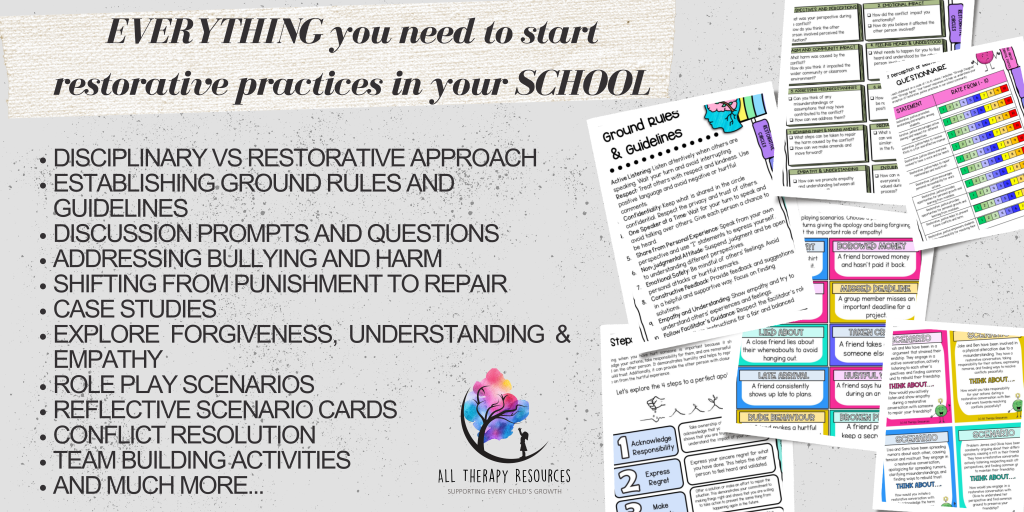













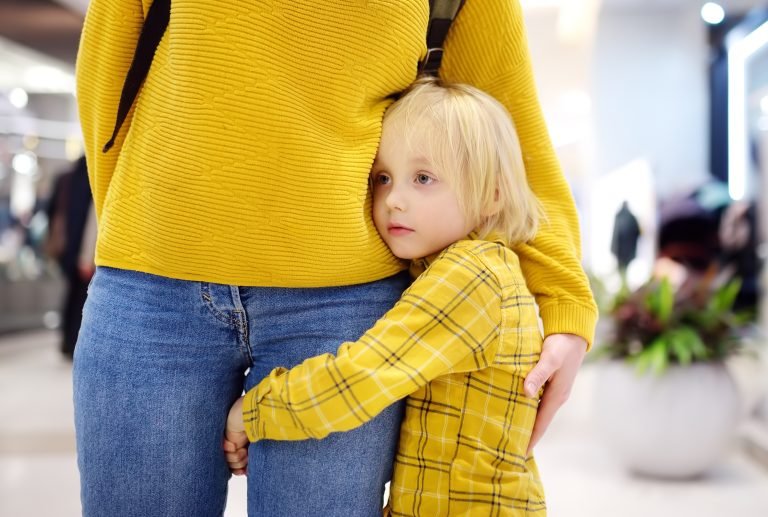

Thank you so much. This has been very informative!